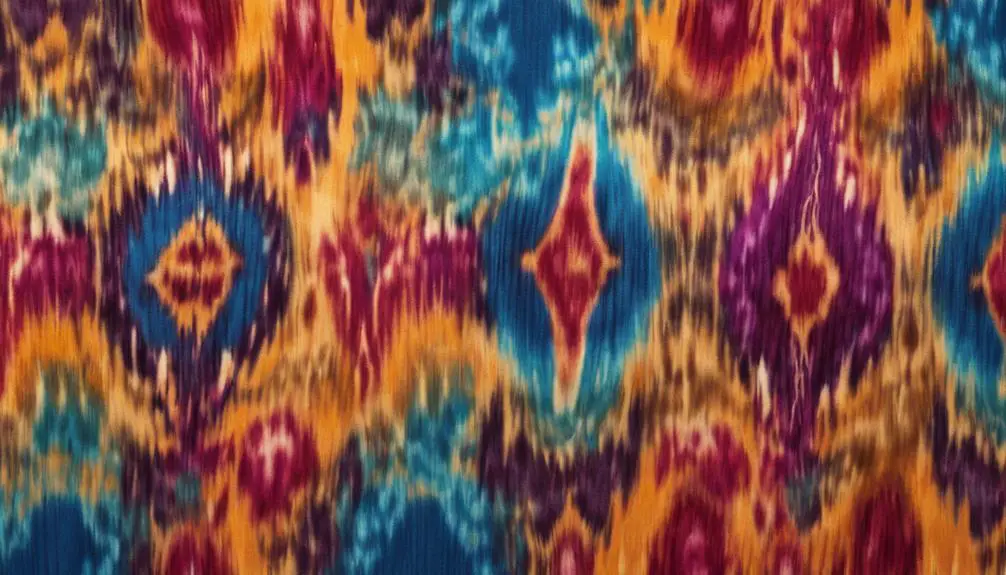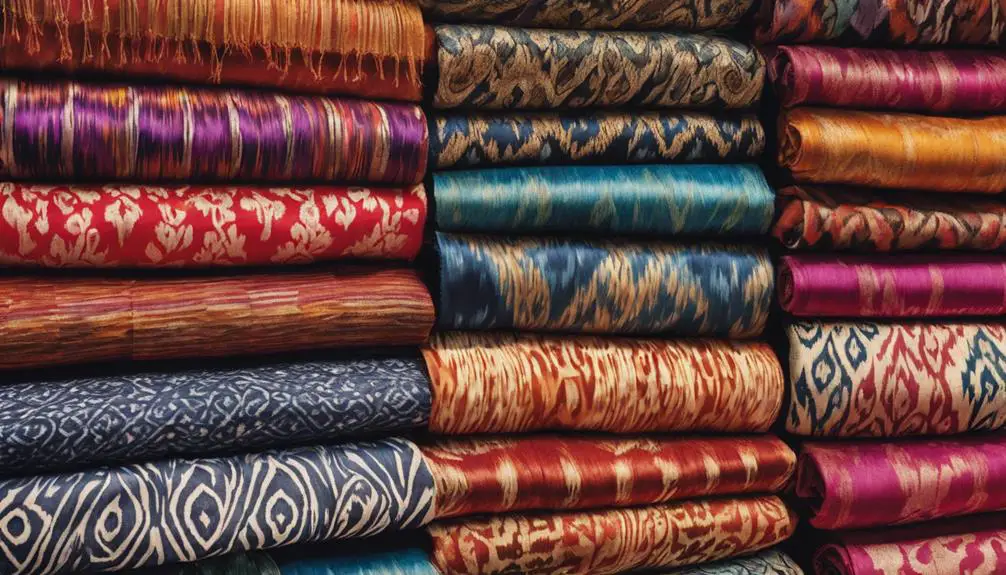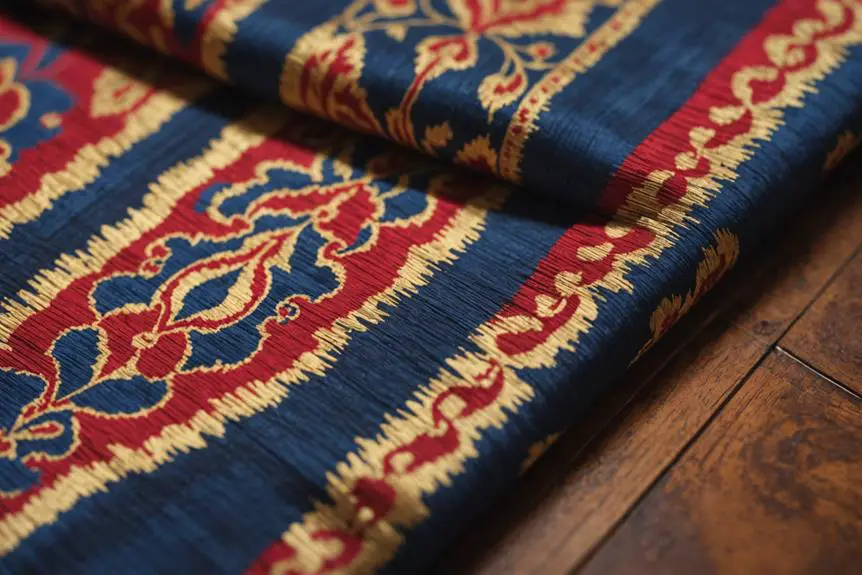When you're trying to identify Ikat silk fabric, start by examining the reverse side for consistent patterns; this can be a strong indicator of authenticity. Notice the blurred edges around motifs, a typical sign of the resist-dyeing technique. You'll also want to feel the texture, as authentic Ikat tends to be slightly coarse compared to synthetic alternatives. But that's just the beginning—there are nuances in the patterns that can reveal even more about the fabric's origin and craftsmanship. Understanding these details could enhance your appreciation for this unique textile, so let's explore further.
Understanding Ikat Silk

Ikat silk is a fascinating fabric created through a unique resist-dyeing technique. Have you ever wondered how those beautiful patterns come to life? Well, it all starts with tying and dyeing threads before they're woven. This intricate resist-dyeing process gives Ikat its signature look, featuring unique patterns that often have slightly blurred edges, adding to its charm.
The term "ikat" actually comes from the Malay-Indonesian word "mengikat," which means to tie or bind. This reflects the traditional craftsmanship involved in making authentic Ikat. Unlike mass-produced textiles that are smooth and uniform, authentic Ikat showcases a slightly coarse texture and irregular patterns—each piece tells a story! Isn't that cool?
You might be surprised to learn that Ikat designs can vary quite a bit. There's warp ikat, which presents patterns along the length of the fabric, and weft ikat, highlighting horizontal motifs. If you're looking for something extra special, double ikat combines both techniques for stunningly intricate designs.
What's more, high-quality Ikat silk is usually handwoven, which means every piece is unique and reflects the artisan's craftsmanship. It's like wearing a piece of cultural heritage! So next time you're browsing for fabric, keep an eye out for Ikat. You'll not only appreciate its beauty but also the rich history and artistry behind it. Isn't that worth celebrating?
Key Characteristics of Ikat
When you explore Ikat silk, you'll quickly notice its key characteristics that set it apart from other fabrics. This unique fabric has a lot going for it, making it a favorite among textile lovers. So, what should you look for?
- Blurred edges around motifs, showcasing the resist dyeing technique.
- Intricate patterns on one side, with the reverse often showing solid colors or less defined designs.
- A slightly coarse texture of Ikat, which feels different from smoother synthetic options.
- Dye migration that creates an organic blend of colors, enhancing the visual depth.
Authentic Ikat is all about that handcrafted nature. Each piece is unique, with irregularities in size and alignment that celebrate the artistry behind it. You may even notice those charming blurred edges that give Ikat its signature look. These aren't just mistakes; they're part of the charm!
Also, the intricate patterns can be mesmerizing. When you hold an Ikat fabric, you're not just holding a textile; you're embracing a story woven by skilled artisans. The slight coarseness of the fabric adds to its character, making it stand out from mass-produced textiles.
Types of Ikat Fabrics

Understanding the key characteristics of Ikat paves the way for appreciating the various types of Ikat fabrics available. So, let's explore the four main types you'll encounter: warp ikat, weft ikat, double ikat, and compound ikat. Each type has its own unique charm and style, thanks to the resist-dyeing process used to create the patterns.
First up is warp ikat. Here, the patterns run along the length of the fabric, often with those signature blurred edges. This happens because the yarns shift during weaving, adding a dreamy quality to the fabric. Then, we have weft ikat, where the magic happens horizontally. Since only the weft threads are dyed, the lines are sharper and more defined, showcasing some serious precision!
Now, if you want to impress your friends, check out double ikat. This one's a real showstopper, as both warp and weft threads are dyed, resulting in intricate designs that can be reversible. Pretty cool, right? Finally, compound ikat combines elements from both warp and weft techniques. The result? Independent but complementary patterns that reflect the rich cultural heritage of the craft.
Recognizing Authentic Ikat
You might find it challenging to distinguish authentic Ikat silk from imitations, but there are key features that can help. By knowing what to look for, you can appreciate the beauty and cultural significance of this unique textile design. Here are some telltale signs of genuine Ikat:
- Blurred edges: Authentic Ikat fabrics often have slightly blurred edges around the motifs. This indicates the handcrafted process of creating these textiles, showcasing the skilled artisans behind the work.
- Reverse side consistency: Flip the fabric over! Genuine Ikat showcases consistent patterns on the reverse side, while printed fabrics might look solid or lack detail.
- Coarse texture: Feel it! Authentic Ikat tends to have a slightly coarse texture, setting it apart from smoother, synthetic fabrics. This texture is part of its artisanal charm.
- Unique irregularities: Keep an eye out for irregularities in patterns. Handcrafted Ikat may have distinct patterns that aren't perfectly symmetrical, adding character to each piece.
The intricate designs in Ikat come from a labor-intensive dyeing process, where skilled artisans create complex patterns through resist-dyeing techniques. This craftsmanship reflects not just skill, but also a rich cultural history. So, next time you're shopping, remember these features to spot the real deal. Embrace the beauty of authentic Ikat and the stories woven into every thread!
Tips for Buying Ikat

Identifying authentic Ikat is just the beginning; knowing how to buy it wisely can elevate your experience. When you're on the hunt for genuine Ikat, remember to check the reverse side of the fabric. Real Ikat usually shows consistent patterns, while printed fabrics might look solid from behind. You want that traditional Ikat charm, right?
Look closely for those slightly blurred edges and little irregularities in the patterns. These features indicate the handmade nature of the textile, showcasing the love and skill poured into each piece. It's like a little fingerprint from the artisan!
Now, don't forget to check the fabric composition. Authentic Ikat is made from pure cotton or silk, so steer clear of anything labeled with polyester blends—yuck!
Pricing is another biggie. Handloom cotton Ikats typically range from 800 to 2500 rupees, while silk Ikats can go from 1500 to a whopping 50,000 rupees. That difference reflects the quality and craftsmanship, so choose wisely!
Lastly, research the seller's reputation. You wouldn't buy a car from a sketchy dealership, would you? Read reviews and make sure you're purchasing from credible sources that specialize in authentic Ikat textiles. Happy shopping! You'll not only find a beautiful piece but also support the artisans who create these stunning works of art!
Frequently Asked Questions
How to Identify Ikat Fabric?
So, you wanna spot Ikat fabric? Look for those unique color patterns and texture differences! It's all about traditional techniques and the dyeing process. Check the weaving methods; genuine Ikat has a bit of a coarse feel. Don't ignore the back—if it's too uniform, it might not be the real deal. Remember, each piece tells a story of its historical origins and regional variations. Excited to find that perfect piece? You got this!
How to Identify Silk Fabric?
To identify silk fabric, start by checking its sheen; real silk has a beautiful, natural glow. You can also do a burn test—it'll smell like burnt hair and leave fine ash. Feel the texture, too; genuine silk is soft and cool, unlike slick polyester. Look for irregularities in the weave, because authentic silk is often handcrafted. Finally, check the label; it should say "silk." Knowing silk's history and uses makes your fashion choices smarter!
What Are the Three Types of Ikat?
So, you're curious about the three types of ikat? You've got warp ikat, where the vertical threads get dyed, creating those cool, blurred patterns. Then, there's weft ikat, which dyes the horizontal threads for sharper designs. Finally, double ikat is the show-off of the bunch, dyeing both sets of threads for intricate motifs. Each type showcases unique ikat techniques, reflecting rich ikat traditions and history. Isn't that fascinating?
How Can You Tell if a Ikat Is Single or Double?
To tell if it's single or double ikat, check for the characteristics! Single ikat shows clear patterns, while double ikat features those beautiful color blending techniques with fuzzy edges. Look closely at the fabric thickness too; double ikat tends to be thicker due to its complex weaving techniques. And if you see intricate patterns from both sides, you've got a winner! Remember, caring for these fabrics is key, so treat 'em right!
Conclusion
So, now you're ready to spot genuine Ikat silk like a pro! Remember to check the reverse side for those cool patterns, feel that slightly coarse texture, and embrace the unique quirks that show off the artisan's skill. When you're out shopping, go for pure silk or cotton, and avoid those sneaky blends. Trust your instincts, and don't be afraid to ask questions—after all, you're the Ikat expert now! Happy fabric hunting!



